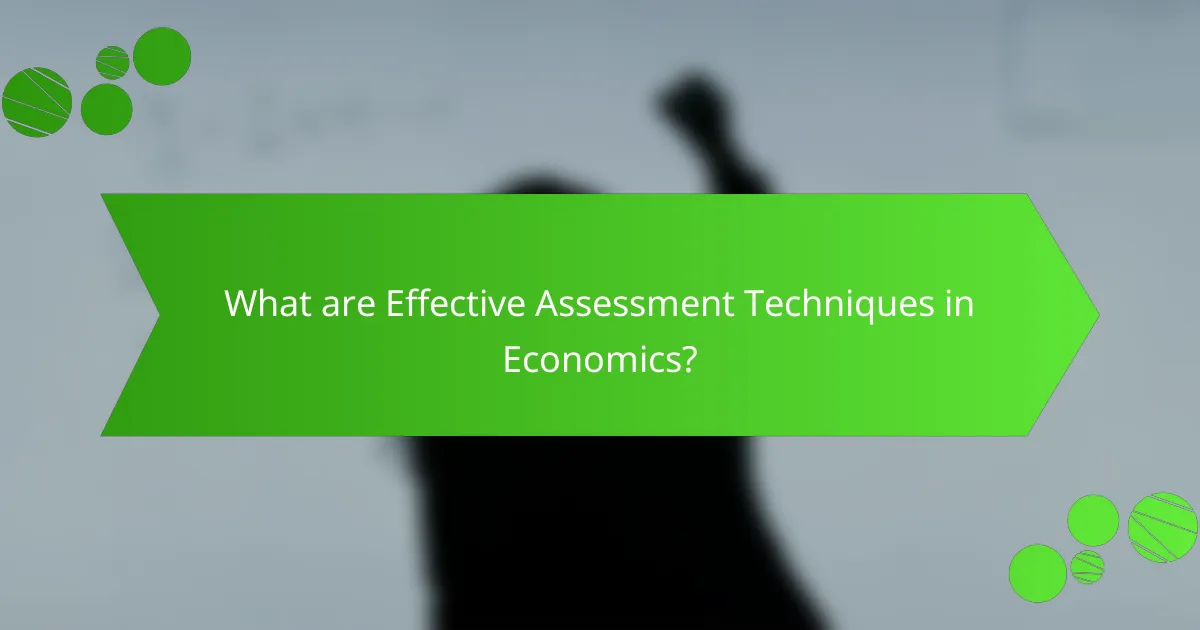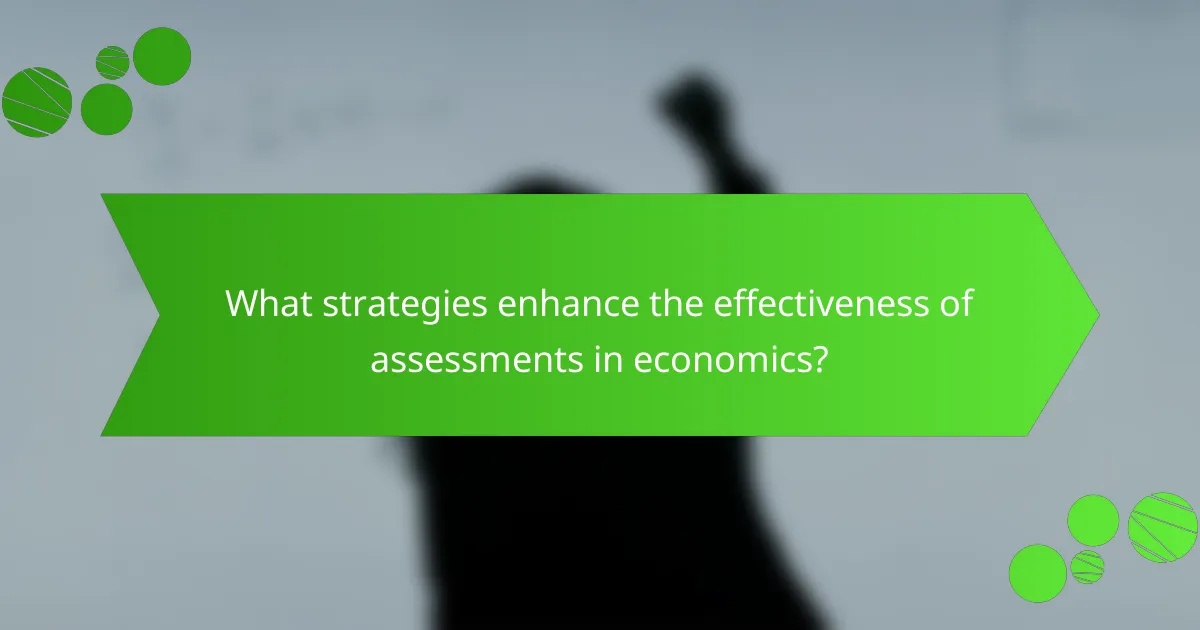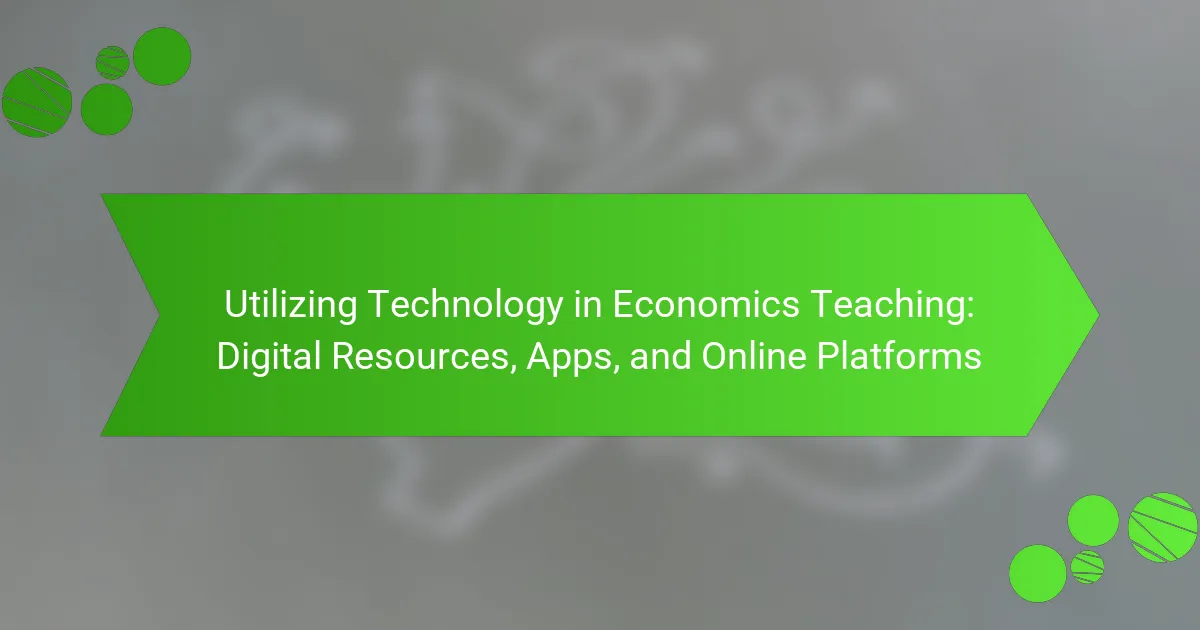Effective assessment techniques in economics encompass formative assessments, summative assessments, and feedback strategies. Formative assessments, such as quizzes and discussions, provide ongoing evaluations to identify student understanding and areas for improvement. Summative assessments, including final exams and projects, evaluate comprehensive learning at the end of instructional units. Feedback strategies offer timely insights into student performance, guiding future learning. The article also addresses challenges in implementing these techniques, such as diverse economic theories, varying student understanding, and the dynamic nature of economic data, while highlighting the importance of aligning assessments with learning objectives and utilizing technology to enhance engagement.

What are Effective Assessment Techniques in Economics?
Effective assessment techniques in economics include formative assessments, summative assessments, and feedback strategies. Formative assessments involve ongoing evaluations throughout the course. They help identify student understanding and areas needing improvement. Examples include quizzes, discussions, and peer assessments. Summative assessments evaluate student learning at the end of an instructional unit. They often take the form of exams or final projects. Feedback strategies provide students with insights into their performance. Timely and constructive feedback helps guide future learning. Research shows that effective assessments can significantly enhance student engagement and understanding in economics.
How do formative assessments contribute to student learning in economics?
Formative assessments enhance student learning in economics by providing ongoing feedback. This feedback helps students identify their strengths and weaknesses. It allows instructors to adjust teaching methods based on student needs. Formative assessments encourage active engagement with the material. They promote self-reflection and self-directed learning among students. Research shows that students who receive regular feedback perform better academically. A study by Hattie and Timperley (2007) found that feedback significantly influences student achievement. Overall, formative assessments are crucial for fostering a deep understanding of economic concepts.
What are the key characteristics of formative assessments in economics?
Formative assessments in economics are ongoing evaluations used to monitor student learning. They provide immediate feedback to improve understanding and performance. These assessments are typically low-stakes, encouraging risk-taking and participation. They can take various forms, including quizzes, discussions, and projects. Formative assessments help identify students’ strengths and weaknesses. They guide instructional adjustments based on student needs. This approach fosters a deeper understanding of economic concepts. Research shows that formative assessments significantly enhance student learning outcomes in economics.
How can formative assessments be effectively implemented in the classroom?
Formative assessments can be effectively implemented in the classroom through regular feedback and interactive activities. Teachers should integrate quick checks for understanding, such as quizzes or polls, during lessons. These assessments provide immediate insights into student comprehension. Additionally, incorporating peer assessments encourages collaboration and critical thinking among students. Using exit tickets at the end of a lesson helps gauge student learning and areas needing improvement. According to research by Black and Wiliam (1998), formative assessments significantly enhance student achievement when used consistently. This study emphasizes the importance of ongoing feedback in promoting student engagement and learning outcomes.
What role do summative assessments play in evaluating economic understanding?
Summative assessments play a crucial role in evaluating economic understanding. They measure students’ knowledge and skills at the end of an instructional period. These assessments provide a comprehensive overview of what learners have achieved. Summative assessments include final exams, standardized tests, and major projects. They help educators determine the effectiveness of their teaching methods. Additionally, they identify areas where students may need further instruction. Research shows that summative assessments can improve learning outcomes by providing feedback on student performance. According to studies, such assessments are linked to higher retention of economic concepts.
What are the different types of summative assessments used in economics?
The different types of summative assessments used in economics include standardized tests, final exams, and cumulative projects. Standardized tests assess students’ understanding through multiple-choice or short-answer questions. Final exams evaluate overall comprehension of the course material at the end of a term. Cumulative projects require students to apply economic concepts to real-world scenarios or case studies. These assessments provide measurable outcomes of student learning. They are essential for determining student proficiency in economics.
How do summative assessments differ from formative assessments?
Summative assessments evaluate student learning at the end of an instructional unit. They typically measure what students have learned and are often used for grading purposes. Examples include final exams, standardized tests, and end-of-term projects. Formative assessments, on the other hand, are conducted during the learning process. They provide ongoing feedback to improve student learning and instructional methods. Examples include quizzes, class discussions, and peer reviews. Summative assessments focus on the outcome, while formative assessments emphasize the learning journey. This distinction is crucial for educators to tailor their teaching strategies effectively.
Why is feedback critical in the assessment process for economics students?
Feedback is critical in the assessment process for economics students because it enhances learning and understanding. It provides students with specific insights into their performance. This guidance helps identify strengths and areas for improvement. Feedback encourages students to reflect on their work. It fosters a growth mindset essential for mastering complex economic concepts. Research indicates that timely feedback can significantly improve academic performance. A study by Hattie and Timperley (2007) highlights that feedback can increase student achievement by up to 30%. Therefore, effective feedback is a vital component of the assessment process in economics education.
What types of feedback are most effective in economics assessments?
Formative feedback is most effective in economics assessments. It provides ongoing insights during the learning process. This type of feedback helps students understand their progress and areas for improvement. Summative feedback, given after assessments, is also valuable but less impactful for immediate learning. Effective feedback should be specific, timely, and constructive. Research indicates that timely feedback can enhance student performance significantly. For instance, a study by Hattie and Timperley (2007) emphasizes that feedback focused on the task can lead to better learning outcomes. Thus, formative feedback is crucial for continuous improvement in economics education.
How can educators provide constructive feedback to enhance learning?
Educators can provide constructive feedback by being specific, timely, and actionable. Specific feedback focuses on particular aspects of a student’s work. Timely feedback ensures students receive insights while the material is still fresh. Actionable feedback gives clear steps for improvement. Research shows that specific, timely, and actionable feedback enhances student learning outcomes. For instance, a study by Hattie and Timperley (2007) in “Review of Educational Research” highlights that effective feedback significantly influences student achievement. Therefore, incorporating these elements into feedback strategies can lead to better learning experiences.

What strategies enhance the effectiveness of assessments in economics?
Utilizing diverse assessment methods enhances the effectiveness of assessments in economics. Combining formative assessments, such as quizzes and discussions, allows for ongoing feedback and adjustment. Summative assessments, like final exams, evaluate comprehensive understanding. Incorporating real-world applications in assessments bridges theory and practice. Providing timely and constructive feedback helps students identify areas for improvement. Collaborative assessments encourage peer learning and critical thinking. Utilizing technology, such as online simulations, engages students and provides interactive learning experiences. These strategies collectively improve student engagement and understanding of economic concepts.
How can technology be integrated into assessment techniques in economics?
Technology can be integrated into assessment techniques in economics through online testing platforms, data analytics, and interactive simulations. Online testing platforms enable real-time assessment and instant feedback for students. These platforms can host various question formats, including multiple-choice and short answer. Data analytics can track student performance over time. This allows educators to identify trends and adjust teaching methods accordingly. Interactive simulations provide practical applications of economic theories. They engage students in real-world scenarios, enhancing understanding. Research shows that technology-enhanced assessments improve student engagement and learning outcomes. For example, a study by the Educause Review found that 75% of students preferred online assessments for their convenience.
What tools are available for conducting assessments in economics?
Assessment tools in economics include surveys, tests, and simulations. Surveys gather data on economic opinions and behaviors. Tests evaluate knowledge on economic concepts and theories. Simulations allow students to apply economic principles in real-world scenarios. Additionally, case studies provide in-depth analysis of economic issues. Online platforms facilitate interactive assessments. These tools enhance understanding and engagement in economics education.
How does technology improve student engagement in assessments?
Technology improves student engagement in assessments by providing interactive and personalized learning experiences. Digital tools like quizzes and gamified assessments increase motivation. These tools allow instant feedback, helping students understand their progress. Online platforms enable collaboration among peers, fostering a sense of community. Multimedia resources, such as videos and simulations, cater to various learning styles. Research by the Educause Center for Analysis and Research found that technology-enhanced assessments lead to higher student satisfaction and performance. Overall, technology creates a more dynamic and engaging assessment environment.
What best practices should educators follow for effective assessments?
Educators should follow several best practices for effective assessments. First, they must align assessments with learning objectives. This ensures that assessments measure what students are intended to learn. Second, they should use a variety of assessment types. This includes formative assessments like quizzes and summative assessments like exams. Third, providing timely and constructive feedback is crucial. Feedback helps students understand their strengths and areas for improvement. Fourth, assessments should be clear and concise. Clear instructions reduce confusion and enhance student performance. Fifth, educators should incorporate self-assessment opportunities. This encourages students to reflect on their learning process. Lastly, using data from assessments to inform instruction is essential. This practice allows educators to adjust teaching strategies based on student performance. These practices are supported by research indicating that effective assessment strategies lead to improved student outcomes.
How can educators design assessments that align with learning objectives?
Educators can design assessments that align with learning objectives by first clearly defining those objectives. They should ensure that assessments measure the specific knowledge and skills outlined in the learning goals. Next, assessments should be varied in format, including multiple-choice, essays, and projects to cater to different learning styles.
Additionally, educators must ensure that the difficulty level of the assessments matches the expected proficiency of students. They can use rubrics to provide clear criteria for evaluation, enhancing transparency in grading. Regular feedback should be integrated into the assessment process to guide student improvement.
Research shows that assessments aligned with learning objectives lead to improved student performance and understanding. A study published in the Journal of Educational Psychology found that students performed better when assessments were directly linked to learning goals.
What common pitfalls should be avoided in assessment design?
Common pitfalls to avoid in assessment design include lack of alignment with learning objectives. Assessments should directly measure the intended outcomes. Another pitfall is over-reliance on a single assessment method. Utilizing diverse methods enhances reliability and validity. Additionally, unclear instructions can confuse students. Clear guidelines ensure that students understand expectations.
Inadequate feedback is also a significant issue. Constructive feedback helps learners improve. Lastly, failing to consider diverse learner needs can limit effectiveness. Assessments should be inclusive to accommodate various learning styles.

What are the challenges faced in implementing effective assessment techniques in economics?
Implementing effective assessment techniques in economics faces several challenges. One challenge is the diversity of economic theories and models. This diversity can complicate the development of standardized assessments. Another challenge is the varying levels of student understanding. Students often have different backgrounds, which affects their grasp of economic concepts.
Additionally, the dynamic nature of economic data presents a challenge. Economic conditions change rapidly, making it difficult to create relevant assessments. There is also the issue of aligning assessments with learning objectives. Misalignment can lead to ineffective evaluation of student knowledge.
Furthermore, limited resources can hinder the implementation of comprehensive assessment techniques. Many educational institutions lack the necessary tools and training. Finally, resistance to change from traditional assessment methods can obstruct progress. Educators may be reluctant to adopt new techniques despite their potential benefits.
How can educators address the challenges of diverse learning styles in assessments?
Educators can address the challenges of diverse learning styles in assessments by incorporating varied assessment methods. This includes using visual, auditory, and kinesthetic approaches to cater to different preferences. For instance, visual learners benefit from diagrams and charts, while auditory learners excel with discussions and presentations. Kinesthetic learners may perform better with hands-on activities or simulations.
Additionally, providing options for students to demonstrate their understanding can enhance engagement. Allowing choices between written reports, presentations, or creative projects accommodates individual strengths. Furthermore, formative assessments can be used to gauge understanding throughout the learning process. This ongoing feedback helps educators adjust their teaching strategies to meet diverse needs.
Research indicates that differentiated assessments can improve student outcomes. A study by Tomlinson (2001) highlights the effectiveness of tailored assessments in enhancing student engagement and success. By implementing these strategies, educators can create a more inclusive assessment environment.
What strategies can be used to accommodate different learning needs?
Differentiated instruction is a key strategy to accommodate different learning needs. This approach tailors teaching methods to suit various learning styles and abilities. Teachers can use flexible grouping to allow students to work in diverse teams. Individualized learning plans can address specific student goals and challenges. Providing varied resources, such as videos, texts, and hands-on materials, supports different learning preferences. Regular formative assessments help identify students’ understanding and adjust instruction accordingly. Feedback should be constructive and specific to guide improvement. Research indicates that these strategies enhance engagement and learning outcomes across diverse classrooms.
How can assessments be made more inclusive for all students?
Assessments can be made more inclusive for all students by incorporating diverse assessment methods. This includes using a variety of formats such as written, oral, and practical assessments. Providing options allows students to demonstrate their understanding in different ways. Additionally, assessments should be designed to accommodate diverse learning needs. This can involve offering extended time, alternative settings, or assistive technologies.
Research indicates that inclusive assessment practices lead to improved student engagement and performance. For instance, a study by the National Center on Educational Outcomes found that inclusive assessments can enhance learning outcomes for students with disabilities. By ensuring that assessments are accessible, educators create a fairer evaluation environment for all students.
What are the implications of assessment results for curriculum development?
Assessment results directly inform curriculum development by identifying student learning gaps and strengths. These results guide educators in adjusting instructional strategies to meet diverse learner needs. For instance, formative assessments reveal areas where students struggle, prompting curriculum modifications to enhance understanding. Summative assessments provide a broader view of overall learning outcomes, influencing long-term curriculum planning. Research indicates that data-driven decisions lead to more targeted teaching approaches. A study by Black and Wiliam (1998) highlights that effective use of assessment results can significantly improve student achievement. Thus, assessment results are crucial for creating responsive and effective curricula.
How can assessment data inform teaching practices in economics?
Assessment data can inform teaching practices in economics by identifying student strengths and weaknesses. It provides insights into areas where students excel and where they struggle. Teachers can adjust their instructional strategies based on this data. For example, if assessment results show low comprehension of supply and demand concepts, teachers can revisit those topics. Formative assessments allow for ongoing feedback, enabling real-time adjustments to teaching methods. Summative assessments help evaluate overall understanding at the end of a unit. Data analysis can guide curriculum development and lesson planning. Studies indicate that data-driven instruction leads to improved student performance in economics.
What steps can be taken to improve the curriculum based on assessment outcomes?
To improve the curriculum based on assessment outcomes, educators should analyze assessment data thoroughly. This analysis identifies strengths and weaknesses in student performance. Based on this data, specific learning objectives can be revised for clarity and relevance. Curriculum materials should be updated to align with these objectives. Additionally, instructional strategies must be adjusted to meet diverse learning needs. Regular feedback from students can guide these adjustments effectively. Professional development for educators can also enhance teaching practices in response to assessment findings. Implementing these steps fosters a more effective learning environment. Studies show that data-driven curriculum adjustments lead to improved student outcomes.
What are some practical tips for implementing effective assessment techniques in economics?
Implementing effective assessment techniques in economics requires clear strategies. First, align assessments with learning objectives. This ensures that evaluations measure relevant knowledge and skills. Second, incorporate diverse assessment methods. Use quizzes, essays, and projects to cater to different learning styles. Third, provide timely feedback. Immediate feedback helps students understand their performance and improve. Fourth, use real-world applications. Case studies can illustrate economic concepts in practical contexts. Fifth, encourage peer assessments. This fosters collaboration and critical thinking among students. Lastly, regularly review and adjust assessment strategies. Continuous improvement keeps the techniques effective and relevant.
Effective Assessment Techniques in Economics focus on formative assessments, summative assessments, and feedback strategies to enhance student learning. Formative assessments provide ongoing evaluations that help identify student understanding and areas for improvement, while summative assessments measure knowledge at the end of instructional units. Feedback is critical in this process, offering insights into performance and guiding future learning. The article explores various assessment methods, their implementation in the classroom, and the implications of assessment results for curriculum development, aiming to improve student engagement and understanding of economic concepts.



